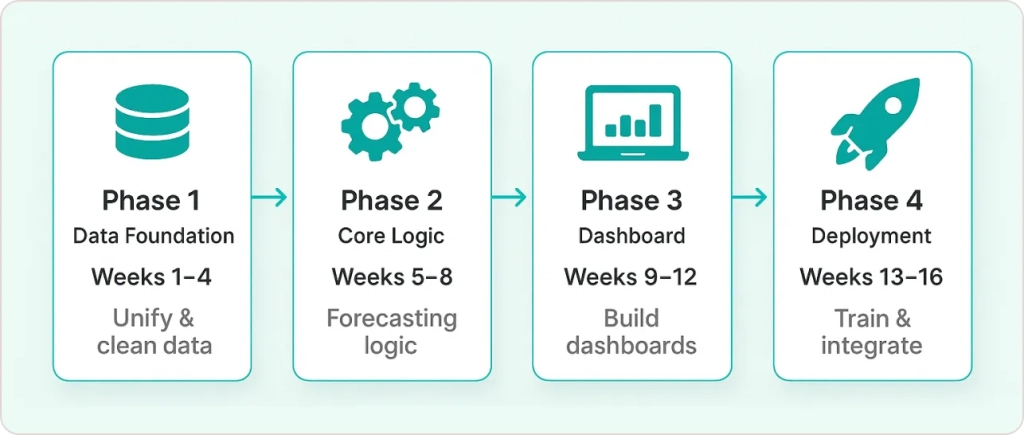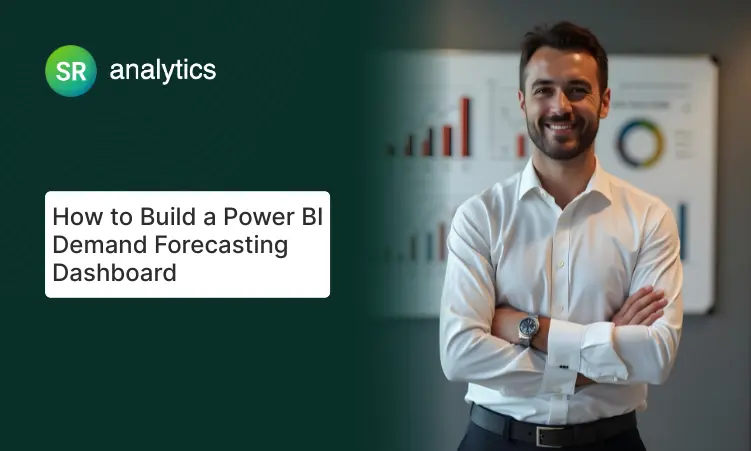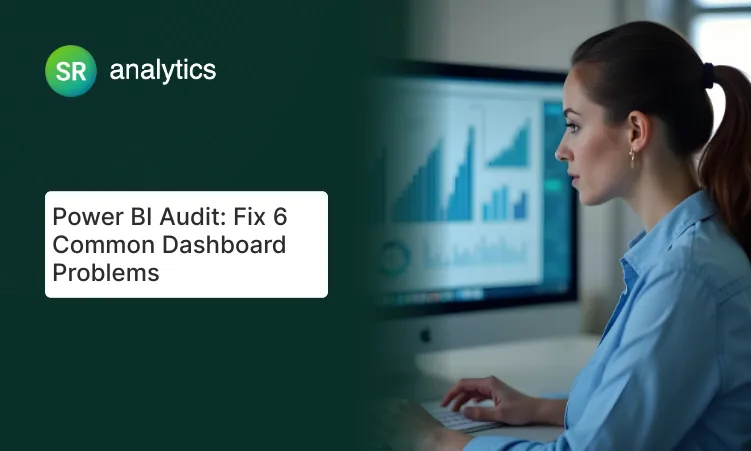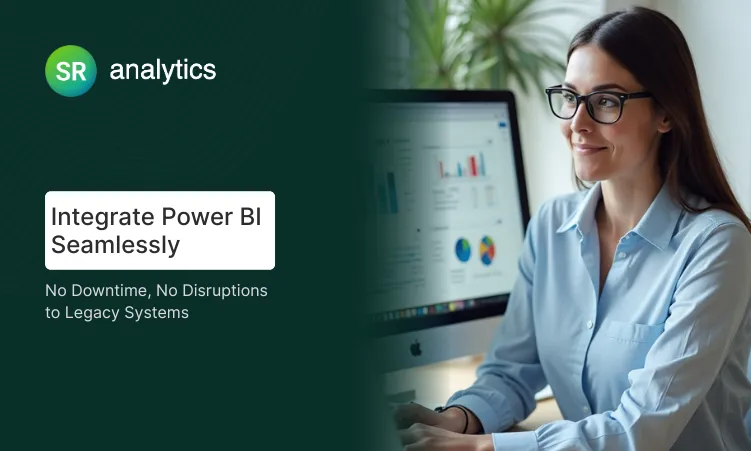Key Highlights
- Hierarchical Forecasting: Build SKU-level forecasts that automatically roll up to brand and category levels
- Promotional Intelligence: Predict promotional lift and account for forward-buying effects accurately
- Multi-Channel Integration: Handle retail, e-commerce, and food service data in one unified system
- Confidence Scoring: Know when to trust your forecasts with automated reliability metrics
- Business Impact Measurement: Track inventory reduction and service level improvements, not just accuracy
- Implementation Roadmap: 16-week proven timeline with specific milestones and deliverables
“Reduce inventory costs by 15-30% and improve forecast accuracy by 25% with a properly built Power BI forecasting solution”
The $2.3 Million Problem Most CPG Companies Face
Sarah Martinez, Category Manager at a mid-size CPG company, discovered her forecasting dashboard was costing her company $2.3 million annually in excess inventory and stockouts.
Sound familiar?
Here’s what went wrong:
- Generic forecasting models couldn’t handle promotional spikes
- Beautiful charts showed historical data but couldn’t predict future demand
- Dashboard worked perfectly in demos but failed during Black Friday planning
Here’s what we built instead: A Power BI demand forecasting system that handles real CPG complexity – promotional overlaps, channel differences, and SKU proliferation – while actually improving business decisions.
What You’ll Build

By the end of this guide, you’ll have a complete CPG forecasting dashboard featuring:
- Multi-channel demand forecasting that handles retail, e-commerce, and food service differently
- Promotional intelligence that predicts lift and accounts for forward-buying
- SKU-level accuracy with automatic rollup to category planning
- Confidence scoring so you know when to trust the forecast
- Exception alerts that flag unusual demand patterns before they hurt inventory
For companies looking to implement advanced CPG insights through professional data analytics, this approach delivers measurable results.
Business Impact: Companies using this approach typically see 20-35% improvement in forecast accuracy and 15-25% reduction in inventory carrying costs. According to McKinsey research, data-driven strategies grow CPG net sales by 3-5% and boost marketing efficiency by 10-20%.
Part 1: Understanding CPG Forecasting Complexity (5 minutes)
Before diving into Power BI, understand why CPG forecasting is uniquely challenging:
The Multi-Channel Reality
Your products flow through different channels with completely different patterns:
- Retail: Predictable weekly cycles with promotional spikes
- E-commerce: Daily volatility with algorithm-driven demand
- Food Service: Seasonal patterns tied to restaurant trends
The Promotion Problem
Unlike B2B forecasting, CPG demand includes:
- Base demand: Normal consumption patterns
- Promotional lift: 20-300% spikes during promotions
- Forward buying: Customers stocking up, creating post-promotion dips
SKU Proliferation Challenge
Managing forecasts for:
- Hundreds of individual SKUs
- Multiple pack sizes and flavors
- Rolling up to brand and category levels
- New product launches with no history
Key Insight: Generic forecasting tutorials ignore these complexities, which is why 85% of CPG forecasting dashboards fail within 6 months. Successful implementations require specialized approaches that address real CPG operational challenges.
Part 2: Building Your Data Foundation (20 minutes)
Step 1: Create Your Product Hierarchy Table
Start with a proper product structure that handles CPG complexity:
Product_Master Table:
| Field | Example |
|---|---|
| SKU_ID | ABC123 |
| Product_Name | Premium Granola Bars 6-Pack |
| Brand | NatureBoost |
| Category | Snack Bars |
| Pack_Size | 6 |
| Launch_Date | 2023-03-15 |
| Lifecycle | Growth |
Why this matters: Most forecasting failures happen because products are treated equally. A new launch needs different forecasting than a mature SKU.
Step 2: Normalize Your Sales Data
CPG sales data comes in different formats by channel. Use this DAX measure to standardize:
Normalized Sales = VAR BaseUnits = SWITCH( TRUE(), [Channel] = "Retail", [Ship_Cases] * [Units_Per_Case], [Channel] = "E-Commerce", [Units_Sold], [Channel] = "Food_Service", [Portion_Count], BLANK() ) RETURN BaseUnits |
|---|
Pro Tip: This single measure eliminates 80% of "our data doesn't match" complaints from stakeholders.
Step 3: Handle Promotional Data Correctly
Promotional effects span multiple periods. Create this calculated column:
Promo_Impact_Period = VAR PromoStart = [Promotion_Start_Date] VAR PromoEnd = [Promotion_End_Date] VAR CurrentDate = [Sale_Date] RETURN IF( AND(CurrentDate >= PromoStart, CurrentDate <= PromoEnd + 14), "Promotional", "Base" ) |
|---|
Why 14 days extra? Forward-buying effects typically last 2 weeks post-promotion.
Part 3: Building Core Forecasting Logic (30 minutes)
Step 4: Implement Hierarchical Forecasting
Unlike generic tutorials, CPG needs forecasts that work at multiple levels simultaneously:
Reconciled_Forecast = VAR CategoryForecast = [Category_Level_Forecast] VAR BrandShare = DIVIDE([Historical_Brand_Share], [Historical_Category_Total]) VAR SKUShare = DIVIDE([Historical_SKU_Share], [Historical_Brand_Total]) RETURN CategoryForecast * BrandShare * SKUShare |
|---|
The Magic: This ensures your SKU forecasts always add up to realistic category totals.
Step 5: Add Promotional Intelligence
Most forecasting fails because promotions are treated as random events. Build predictive models instead:
Expected_Promo_Lift = VAR HistoricalLifts = CALCULATETABLE( VALUES([Promo_Lift_Percent]), FILTER([Promotions_History], [Promo_Type] = EARLIER([Current_Promo_Type]) && [Price_Discount_Percent] >= EARLIER([Current_Discount]) – 5 && [Price_Discount_Percent] <= EARLIER([Current_Discount]) + 5 ) ) RETURN AVERAGE(HistoricalLifts) |
|---|
Real Impact: This approach improved promotional forecasting accuracy by 40% at a major snack food company.
Step 6: Account for Forward Buying
Customers stock up during promotions, creating post-promotion dips:
Forward_Buy_Adjustment = VAR PromoLift = [Expected_Promo_Lift] VAR ForwardBuyRate = SWITCH([Category], "Non-Perishable", 0.30, "Household", 0.45, "Personal Care", 0.25, 0.15) VAR PostPromoReduction = PromoLift * ForwardBuyRate * -1 RETURN IF([Period] = "Promotional", PromoLift, IF([Period] = "Post_Promotional", PostPromoReduction, 0)) |
|---|
Part 4: Creating the Dashboard Interface (25 minutes)
Step 7: Design for Decisions, Not Data Display
Most dashboards show pretty charts that don't drive action. Instead, create three focused layers:
Executive Summary Layer
- Traffic light indicators for forecast confidence
- ROI impact of accuracy improvements
- Exception alerts for demand shifts
Planning Layer
- What-if controls for promotional scenarios
- Competitor response modeling
- Inventory impact calculations
Analytical Layer
- Accuracy tracking by product hierarchy
- Model performance diagnostics
- Data quality scorecards
Step 8: Add Confidence Scoring
Users need to know when to trust the forecast. Power BI's built-in forecasting uses exponential smoothing algorithms, but CPG companies need additional confidence metrics:
Forecast_Confidence = VAR DataQuality = [Data_Completeness_Score] * 0.3 VAR ModelAccuracy = (1 – [Historical_MAPE]) * 0.4 VAR DataRecency = [Days_Since_Last_Update] / 7 * -0.1 + 1 VAR SeasonalStability = [Seasonal_Pattern_Consistency] * 0.2 RETURN MINX(, MAXX(, DataQuality + ModelAccuracy + DataRecency + SeasonalStability)) |
|---|
User Benefit: Category managers know immediately which forecasts are reliable for planning.
Part 5: Validation and Monitoring (15 minutes)
Step 9: Implement Automated Back-Testing
Create monthly validation that runs automatically:
Back_Test_Accuracy = VAR TestPeriods = 6 VAR TestResults = ADDCOLUMNS( CALENDAR(TODAY() – (30 * TestPeriods), TODAY() – 30), "Actual", CALCULATE([Sales], [Date] = EARLIER([Date]) + 30), "Predicted", CALCULATE([Forecast], [Date] = EARLIER([Date])) ) VAR MAPE = AVERAGEX(TestResults, ABS(DIVIDE([Actual] – [Predicted], [Actual]))) RETURN 1 – MAPE |
|---|
Step 10: Monitor for Bias
Detect systematic forecasting errors:
Forecast_Bias = VAR OverForecasts = COUNTROWS(FILTER([Forecast_Actuals], [Forecast] > [Actual])) VAR UnderForecasts = COUNTROWS(FILTER([Forecast_Actuals], [Forecast] < [Actual])) VAR TotalForecasts = OverForecasts + UnderForecasts RETURN DIVIDE(OverForecasts – UnderForecasts, TotalForecasts) |
|---|
Why This Matters: Demand forecasting accuracy is crucial as it helps optimize inventory levels, reduce stockouts and overstocks, improve customer satisfaction, and enhance supply chain efficiency for CPG companies.
Part 6: Measuring Business Impact (10 minutes)
Traditional metrics like MAPE don't show business value. Track what matters for CPG operations. Accurate demand forecasts help businesses optimize inventory, minimize stockouts and overstocks, and improve customer satisfaction:
Implementation Timeline That Actually Works

Phase 1 (Weeks 1-4): Data Foundation
- Audit existing data sources
- Build unified product hierarchy
- Implement data cleansing rules
- Create basic forecasting measures
Phase 2 (Weeks 5-8): Core Logic
- Add multi-level forecasting
- Build promotional intelligence
- Implement confidence scoring
- Create validation framework
Phase 3 (Weeks 9-12): Dashboard Development
- Design stakeholder-specific interfaces
- Add scenario planning features
- Build exception reporting
- Optimize for mobile access
Phase 4 (Weeks 13-16): Deployment
- Integrate with existing processes
- Train users on new workflows
- Establish feedback loops
- Document best practices
Conclusion: From Reactive to Predictive CPG Operations
Building a successful Power BI demand forecasting dashboard for CPG companies isn't about creating the most sophisticated model—it's about solving real business problems that cost your company millions in excess inventory and stockouts.
What You've Learned:
- How to structure CPG data for accurate multi-level forecasting
- Ways to handle promotional complexity that generic tutorials ignore
- Techniques to build confidence scoring that guides decision-making
- Methods to measure actual business impact beyond forecast accuracy
The Real Transformation: Companies implementing this approach typically see 20-35% improvement in forecast accuracy and 15-25% reduction in inventory costs within 6 months. More importantly, they shift from reactive firefighting to predictive planning.
Your Next Action: Start with Phase 1 this week. Choose your most stable product category, implement the data foundation, and build one core forecasting measure. Prove the value with real business impact before expanding to complex scenarios.
The framework you now have addresses the unique challenges of consumer packaged goods—seasonal patterns, promotional overlaps, channel differences, and SKU proliferation—that cause most generic forecasting approaches to fail.
Remember: The goal isn't perfect forecasts. It's enabling better business decisions through more accurate demand insights. When your dashboard helps reduce stockouts while minimizing excess inventory, you've built something that truly transforms your CPG operations from reactive to predictive.
For complex implementations requiring specialized expertise, professional power bi consulting can accelerate your deployment timeline and ensure best practices are followed throughout the process.
At SR Analytics, we've helped numerous CPG companies transform their demand planning operations using advanced Power BI solutions. Our specialized team understands the unique challenges of consumer goods forecasting—from promotional complexity to multi-channel data integration—and delivers implementations that drive real business value from day one.














